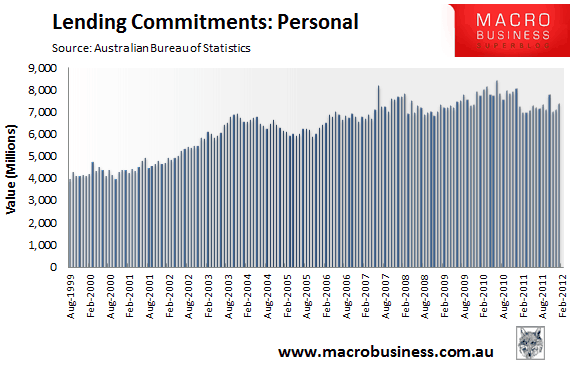On the back of the recent RBA research into credit/debit card and ATM cash usage, comes this “Consumer Credit Expectations Survey” from Dun and Bradstreet:
Families and low income earners are increasingly struggling to meet their financial obligations, relying more on credit to pay the bills in the coming months.
….41 per cent of Australian households with children will be forced to rely on a credit card to cover living expenses, up two percent since late last year.
Management of outstanding debt is also becoming a greater problem for households, particularly low-income:
The survey of June quarter savings, credit usage, spending and debt performance expectations, also found over a third of Australian families will struggle to manage existing debt levels.
Similarly, nearly half (46%) of all low-income households expect difficulty managing their debt. This represents a rise of eight percentage points since the fourth quarter of 2011, 11 points above the national average.
The results suggest a debt deflationary pincer where the ” least-solvent consumers accumulating unmanageable levels of debt, while those best able to meet credit commitments are avoiding spending altogether”:
A growing number of households earning less than $50,000 a year are planning to use credit to cover costs (41%), up from 37 per cent in the December quarter 2011. However, despite growing financial strain, 27 per cent of families plan to apply for new credit or a limit increase during the June quarter.
Nearly one-in-three low-income households expect rising household debt levels, but with limited ability to pay this down. When consumers are increasingly forced to accumulate debt they are unable to manage, just to keep the family finances afloat, this has the potential to quickly become a vicious cycle.
What are households likely to cut back on? Mortgages:
Nearly one in five (19%) low-income households would sacrifice an electricity bill, three percentage points above the national average.
Of those families that do find themselves short of cash in the coming months, more than one in ten (12%) would default on a mortgage repayment or internet bill. Fourteen per cent of families would choose to default on their pay television account.
While six per cent would forgo a mortgage repayment. The survey also found 18 per cent of 25-34 year-olds said this would be the first bill to be sacrificed during low cash flow periods.This also increased noticeably among West Australian (up 13 points to 20%) and Victorian (up six points to 11 per cent) consumers.
Overall, more than one in four (26%) Australian consumers would forgo a mortgage payment if short of funds. This comes as more consumers plan to use redraw facilities on their mortgage to make a major purchase, up four percentage points year-on-year to 22 per cent.
There is a bright side (sic) – we want to borrow more to finance personal consumption:
Overall, more people intend to apply for new credit products and limit increases, particularly younger Australians, households with children and middle-income earners.
Twenty-seven per cent of families and middle-income households plan to access new credit in the June quarter, although uptake was most noticeable among 18-34 year olds, with over a third planning to access new lines of credit – up seven percentage points since Q4 last year.
Overall, the proportion of consumers with a personal loan rose five percentage points to 24 per cent since last year, as more consumers expect to use a personal loan to pay for a major purchase in the coming months (20% compared with 16% Q4 2011).
This survey result is showing up in the official stats, where personal finance increased by 4.3% (seasonally adjusted) in January:

The full report can be found at Dun and Bradstreet.

